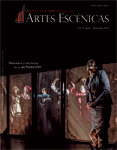Authors
Abstract
This paper is part of the doctoral research entitled “O ator em solidão: passagem de intérprete a autor da cena na criação de um espetáculo unipessoal” whose main objective is to study the one-man show as a privileged authorship space for the contemporary actor. This article presents a preliminary reflection about what is understood as interpretation in the case of the art of the actor in the Western World from several perspectives of his relationship with the dramatic text and the director figure. The main purpose of this paper is to recognize a tradition that gave the actor the place of an intermediary between speeches. In order to do this, a literature review which implies authors of the history and basic theatrical theory in the conceptualization of of the western actor was carried out. Once the function of the actor as an interpreter is recognized, this article leaves open the possibility of emancipation from that function.
References
Carvalho, E. (1989). História e formação do ator.São Paulo: Ática.
Craig, E.G. (2012). O ator e a supermarionete. Sala Preta. Revista do PPGAC da USP, 1(12). Recuperado de
http://www.revistasalapreta.c o m . b r / i n d e x . p h p / s a l a p r e t a / a r t i c l e /view/422/411
Derrida, J. (2001). O teatro da crueldade e o fechamento da representação. En Derrida, J., A escritura e a diferença (pp. 339-365). São Paulo: Perspectiva.
Ferracini, R. (2001). A arte de não interpretar como poesia corpórea do ator. Campinas: Editora da Unicamp, Imprensa Oficial do Estado –Imesp.
________. (2010). Nem interpretar, nem representar. Atuar. En Mostaço, E. (Org.), Para um história cultural do teatro (pp. 309-331). Florianópolis/Jaraguá do Sul: Design.
________. (2013). Atuação como composição de afetos. En Ferracini, R., Ensaios de atuação.São Paulo: Perspectiva.
Furtado Mendes, C. (2008). A gargalhada de Ulisses: a catarse na comédia. São Paulo: Perspectiva.
Marfuz, L. (2013). Beckett, Kantor e as encruzilhadas no trabalho do ator. PesquisAtor.Revista do Centro de Pesquisa em Experimentação Cênica do Ator, 2. Recuperado de http://www.revistas.usp.br/pesquisator/article/view/44967
Portich, A. (2008). A arte do ator entre os séculos XVI e XVIII: da commedia dell’arte ao Paradoxo sobre o comediante. São Paulo: Perspectiva/Fapesp.
Roubine, J.-J. (1998). A linguagem da encenação teatral. Rio de Janeiro: Zahar.
________. (2011). A arte do ator. 2. ed. Rio de Janeiro: Zahar.

 PDF (Español)
PDF (Español)
 FLIP
FLIP









